Numerical Simulation of Selective Laser Melting of 304 L Stainless Steel
Abstract
:1. Introduction
2. Basic Theory and Model of SPH Method
2.1. Construction of the SPH Equation
2.1.1. Integral Notation
2.1.2. Particle Approximation
2.2. Fluid Control Equations
2.3. Modified SPH Equation
2.3.1. Artificial Viscosity
2.3.2. Artificial Stress
2.3.3. Artificial Heat
2.4. SPH Solid Wall Boundary Conditions
2.5. Surface Tension and Wetting Effect
2.5.1. Surface Tension Model
2.5.2. Wetting Effect
2.6. Marangoni Shear Force
2.7. Backlash Pressure
3. Model Verification and Experimental Results
3.1. Validation Example of Wall Droplet Wetting Effect Model
3.2. SPH Numerical Simulation Results and Analysis
3.2.1. Thermophysical Parameters of 304 L Austenitic Stainless Steel
3.2.2. Random Powder Bed Model
3.2.3. SPH Simulation Results
4. Conclusions
Author Contributions
Funding
Data Availability Statement
Conflicts of Interest
References
- Alghamdi, A.; Maconachie, T.; Downing, D.; Brandt, M.; Qian, M.; Leary, M. Effect of additive manufactured lattice defects on mechanical properties: An automated method for the enhancement of lattice geometry. Int. J. Adv. Manuf. Technol. 2020, 108, 957–971. [Google Scholar] [CrossRef]
- Sanaei, N.; Fatemi, A. Defects in additive manufactured metals and their effect on fatigue performance: A state-of-the-art review. Prog. Mater. Sci. 2020, 117, 100724. [Google Scholar] [CrossRef]
- Chen, X.; Mu, W.; Xu, X.; Liu, W.; Huang, L.; Li, H. Numerical analysis of double track formation for selective laser melting of 316L stainless steel. Appl. Phys. A 2021, 127, 586. [Google Scholar] [CrossRef]
- Vrana, R.; Jaros, J.; Koutny, D.; Nosek, J.; Zikmund, T.; Kaiser, J.; Palousek, D. Contour laser strategy and its benefits for lattice structure manufacturing by selective laser melting technology. J. Manuf. Process. 2022, 74, 640–657. [Google Scholar] [CrossRef]
- Fabbro, R. Scaling laws for the laser welding process in keyhole mode. J. Mater. Process. Technol. 2019, 264, 346–351. [Google Scholar] [CrossRef] [Green Version]
- Lee, Y.S.; Zhang, W. Modeling of heat transfer, fluid flow and solidification microstructure of nickel-base superalloy fabricated by laser powder bed fusion. Addit. Manuf. 2016, 12, 178–188. [Google Scholar] [CrossRef] [Green Version]
- Biegler, M.; Elsner, B.A.M.; Graf, B.; Rethmeier, M. Geometric distortion-compensation via transient numerical simulation for directed energy deposition additive manufacturing. Sci. Technol. Weld. Join. 2020, 25, 468–475. [Google Scholar] [CrossRef]
- Zhang, S.; Wei, Q.S.; Lin, G.K.; Zhao, X.; Shi, Y.S. Effects of Powder Characteristics on Selective Laser Melting of 316L Stainless Steel Powder. Adv. Mater. Res. 2011, 189, 3664–3667. [Google Scholar] [CrossRef]
- Galinovsky, A.L.; Kravchenko, I.N.; Martysyuk, D.A.; Seliverstova, E.V.; Sinavchian, S.N.; Pirogov, V.V.; Bykova, A.D. Granulometric Analysis of Powder Materials Used for Producing Samples by Method of Selective Laser Melting. Metallurgist 2022, 66, 688–697. [Google Scholar] [CrossRef]
- Russell, M.; Souto-Iglesias, A.; Zohdi, T. Numerical simulation of Laser Fusion Additive Manufacturing processes using the SPH method. Comput. Methods Appl. Mech. Eng. 2018, 341, 163–187. [Google Scholar] [CrossRef]
- Zhou, R.H.; Liu, H.S.; Wang, H.F. Modeling and simulation of metal selective laser melting process: A critical review. Int. J. Adv. Manuf. Technol. 2022, 121, 5693–5706. [Google Scholar] [CrossRef]
- Ao, X.; Liu, J.; Xia, H.; Yang, Y. A Numerical Study on the Mesoscopic Characteristics of Ti-6Al-4V by Selective Laser Melting. Materials 2022, 15, 2850. [Google Scholar] [CrossRef]
- Liu, H.; Pang, J.; Wang, J.; Yi, X. New heat source model for accurate estimation of laser energy absorption near free surface in selective laser melting. Extrem. Mech. Lett. 2022, 56, 101894. [Google Scholar] [CrossRef]
- Chiumenti, M.; Neiva, E.; Salsi, E.; Cervera, M.; Badia, S.; Moya, J.; Chen, Z.; Lee, C.; Davies, C. Numerical modelling and experimental validation in Selective Laser Melting. Addit. Manuf. 2017, 18, 171–185. [Google Scholar]
- Qiu, Y.; Niu, X.; Song, T.; Shen, M.; Li, W.; Xu, W. Three-dimensional numerical simulation of selective laser melting process based on SPH method. J. Manuf. Process. 2021, 71, 224–236. [Google Scholar] [CrossRef]
- Li, W.; Shen, M.; Meng, L.; Luo, P.; Liu, Y.; Ma, J.; Niu, X.; Wang, H.; Cheng, W.; Wei, T. Establishment of a three-dimensional mathematical model of SLM process based on SPH method. Comput. Part. Mech. 2023, 1–17. [Google Scholar] [CrossRef]
- Long, T.; Huang, H. An improved high order smoothed particle hydrodynamics method for numerical simulations of selective laser melting process. Eng. Anal. Bound. Elem. 2023, 147, 320–335. [Google Scholar] [CrossRef]
- Dao, M.H.; Lou, J. Simulations of Laser Assisted Additive Manufacturing by Smoothed Particle Hydrodynamics. Comput. Methods Appl. Mech. Eng. 2020, 373, 113491. [Google Scholar] [CrossRef]
- Monaghan, J.J.; Kocharyan, A. SPH simulation of multi-phase flow. Comput. Phys. Commun. 1995, 87, 225–235. [Google Scholar] [CrossRef]
- Gray, J.P.; Monaghan, J.J.; Swift, R.P. SPH Elastic Dynamics. Comput. Methods Appl. Mech. Engrg. 2001, 190, 6641–6662. [Google Scholar] [CrossRef]
- Han, Y.W.; Qiang, H.F.; Zhao, J.L.; Gao, W.R. A new repulsive model for solid boundary condition in smoothed particle hydrodynamics. Acta Phys. Sin. 2013, 62, 044702. [Google Scholar] [CrossRef]
- Brackbill, J.U.; Kothe, D.B.; Zemach, C. A continuum method for modeling surface tension. J. Comput. Phys. 1992, 100, 335–354. [Google Scholar] [CrossRef]
- Hu, X.; Adams, N. A multi-phase SPH method for macroscopic and mesoscopic flows. J. Comput. Phys. 2006, 213, 844–861. [Google Scholar] [CrossRef]
- Zhang, Z.; Gogos, G. Theory of shock wave propagation during laser ablation. Phys. Rev. B 2004, 69, 235403.1–235403.9. [Google Scholar] [CrossRef]
- Anisimov, S.I.; Khokhlov, V.A. Instabilities in Laser-Matter Interaction; CRC Press: Boca Raton, FL, USA, 1995. [Google Scholar]
- Kalashnikova, T.A.; Khoroshko, E.S.; Chumaevskii, A.V.; Filippov, A.V. Surface morphology of 321 stainless steel obtained by electron-beam wire-feed additive manufacturing technology. AIP Conf. Proc. 2018, 2051, 020114. [Google Scholar] [CrossRef]
- Cao, L. Numerical simulation of the impact of laying powder on selective laser melting single-pass formation. Int. J. Heat Mass Transf. 2019, 141, 1036–1048. [Google Scholar] [CrossRef]
- Yuan, W.; Chen, H.; Cheng, T.; Wei, Q. Effects of laser scanning speeds on different states of the molten pool during selective laser melting: Simulation and experiment. Mater. Des. 2020, 189, 108542. [Google Scholar] [CrossRef]
- Khairallah, S.A.; Anderson, A.T.; Rubenchik, A.; King, W.E. Laser powder-bed fusion additive manufacturing: Physics of complex melt flow and formation mechanisms of pores, spatter, and denudation zones. Acta Mater. 2016, 108, 36–45. [Google Scholar] [CrossRef] [Green Version]
- Guan, K.; Wang, Z.; Gao, M.; Li, X.; Zeng, X. Effects of processing parameters on tensile properties of selective laser melted 304 stainless steel. Mater. Des. 2013, 50, 581–586. [Google Scholar] [CrossRef]
- Khairallah, S.A.; Anderson, A. Mesoscopic simulation model of selective laser melting of stainless steel powder. J. Mater. Process. Technol. 2014, 214, 2627–2636. [Google Scholar] [CrossRef]
- Liu, S.; Liu, J.; Chen, J.; Liu, X. Influence of surface tension on the molten pool morphology in laser melting. Int. J. Therm. Sci. 2019, 146, 106075. [Google Scholar] [CrossRef]

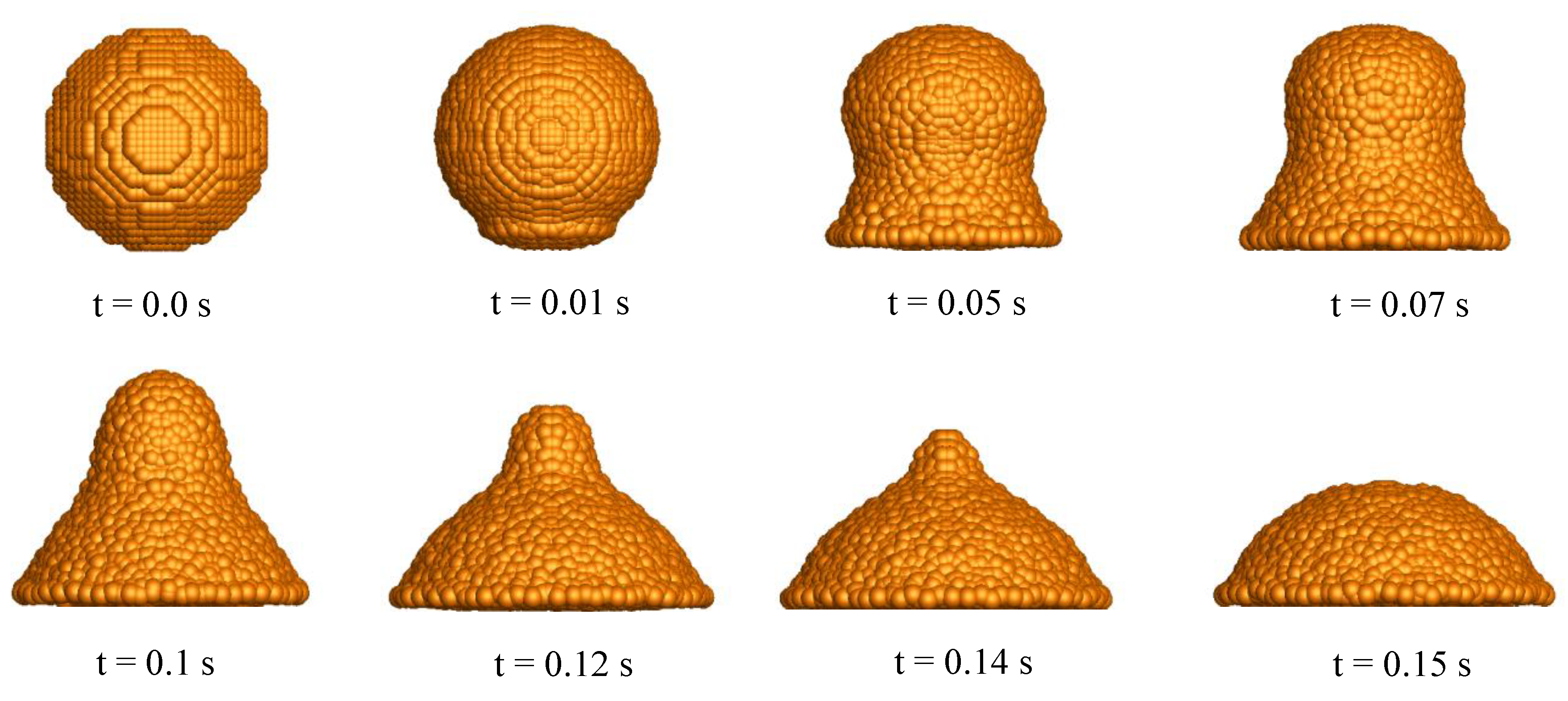

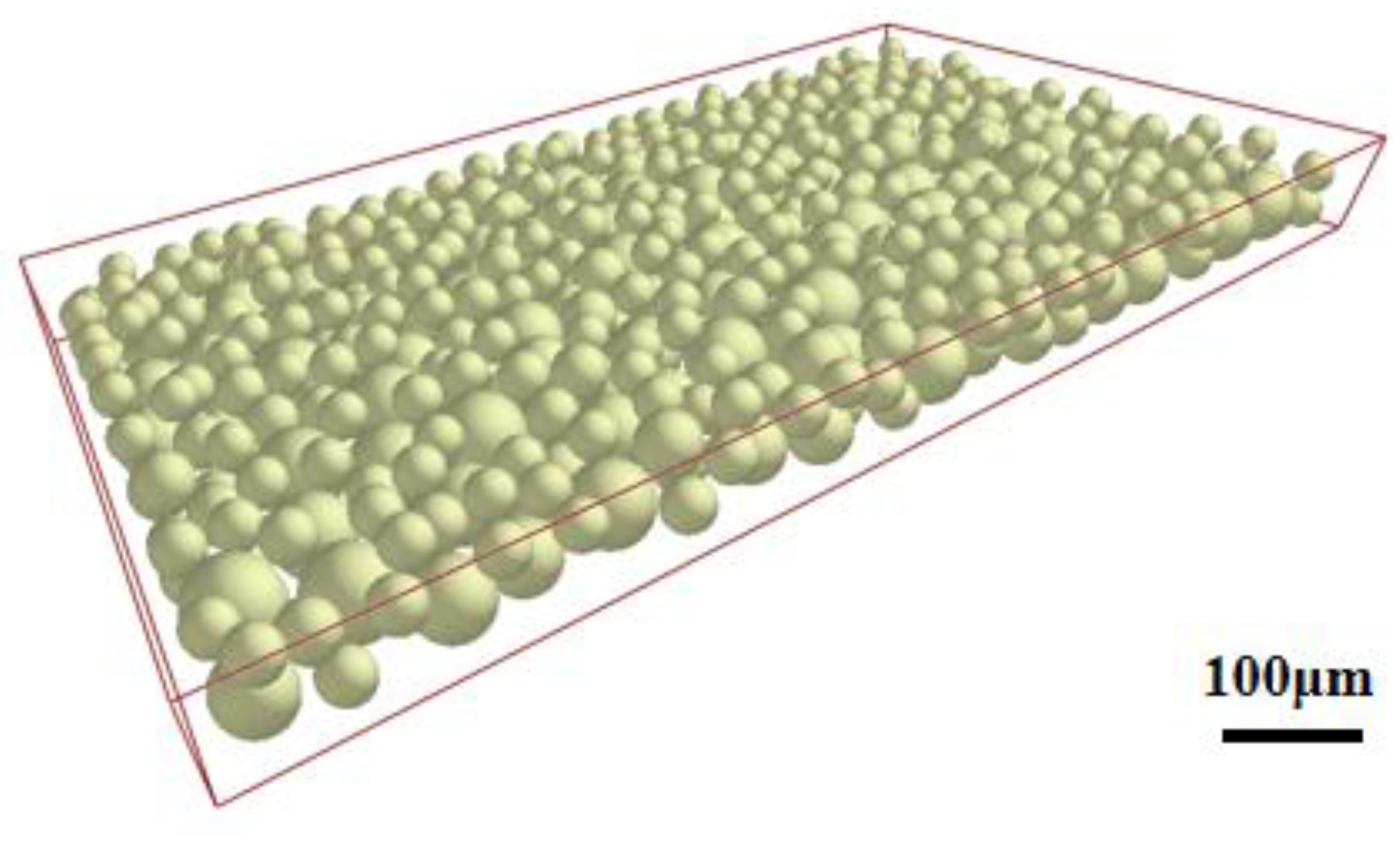

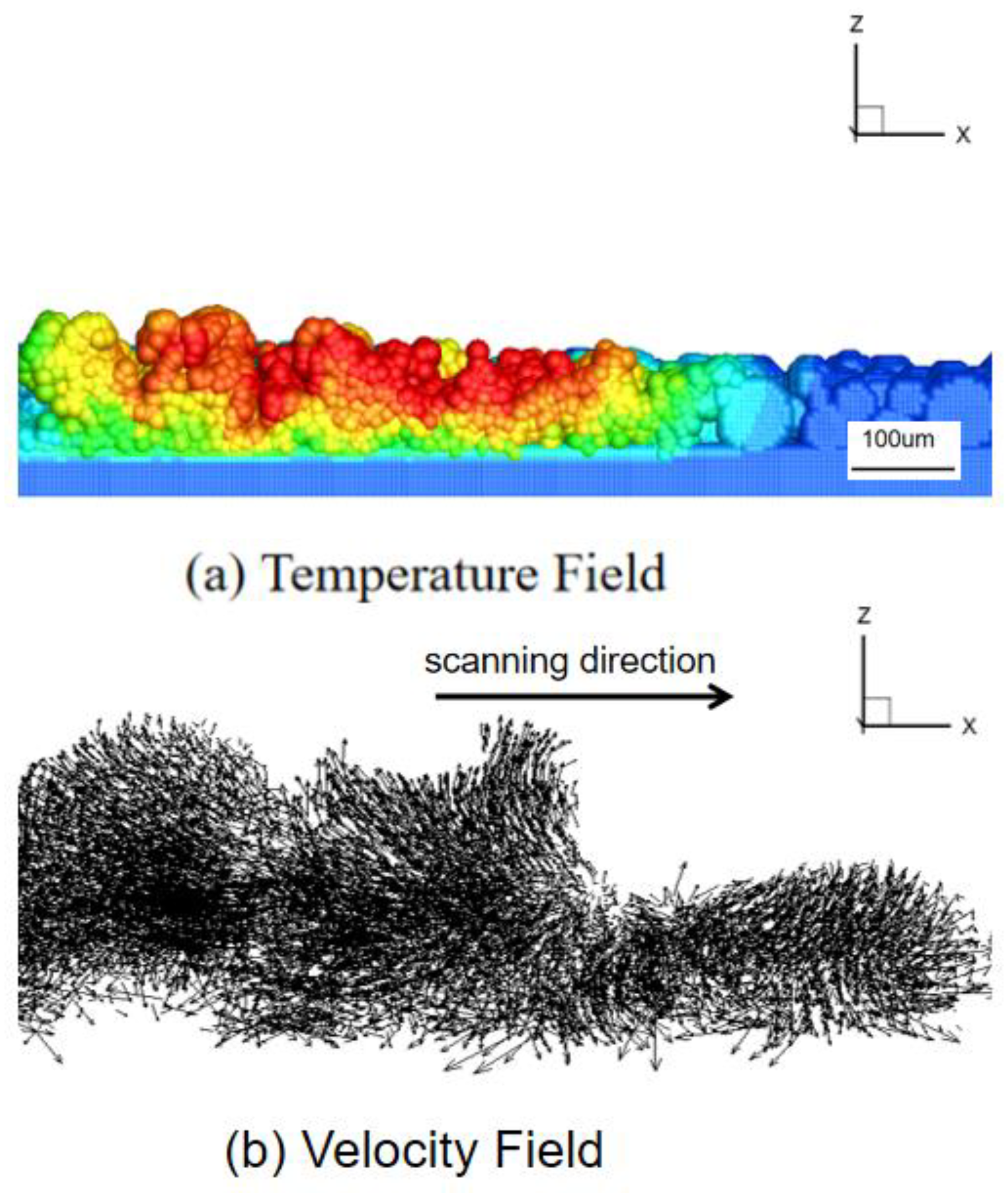
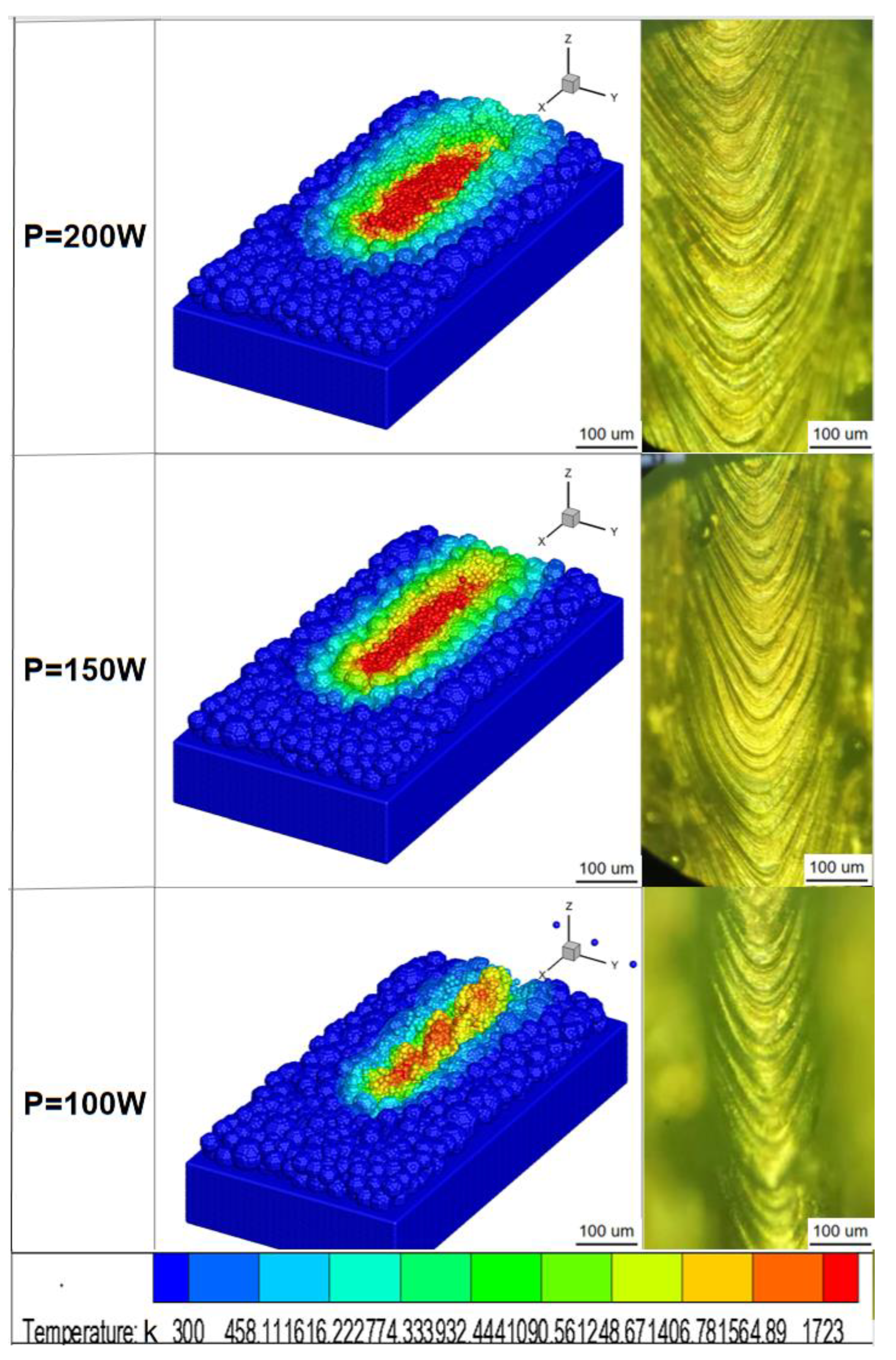
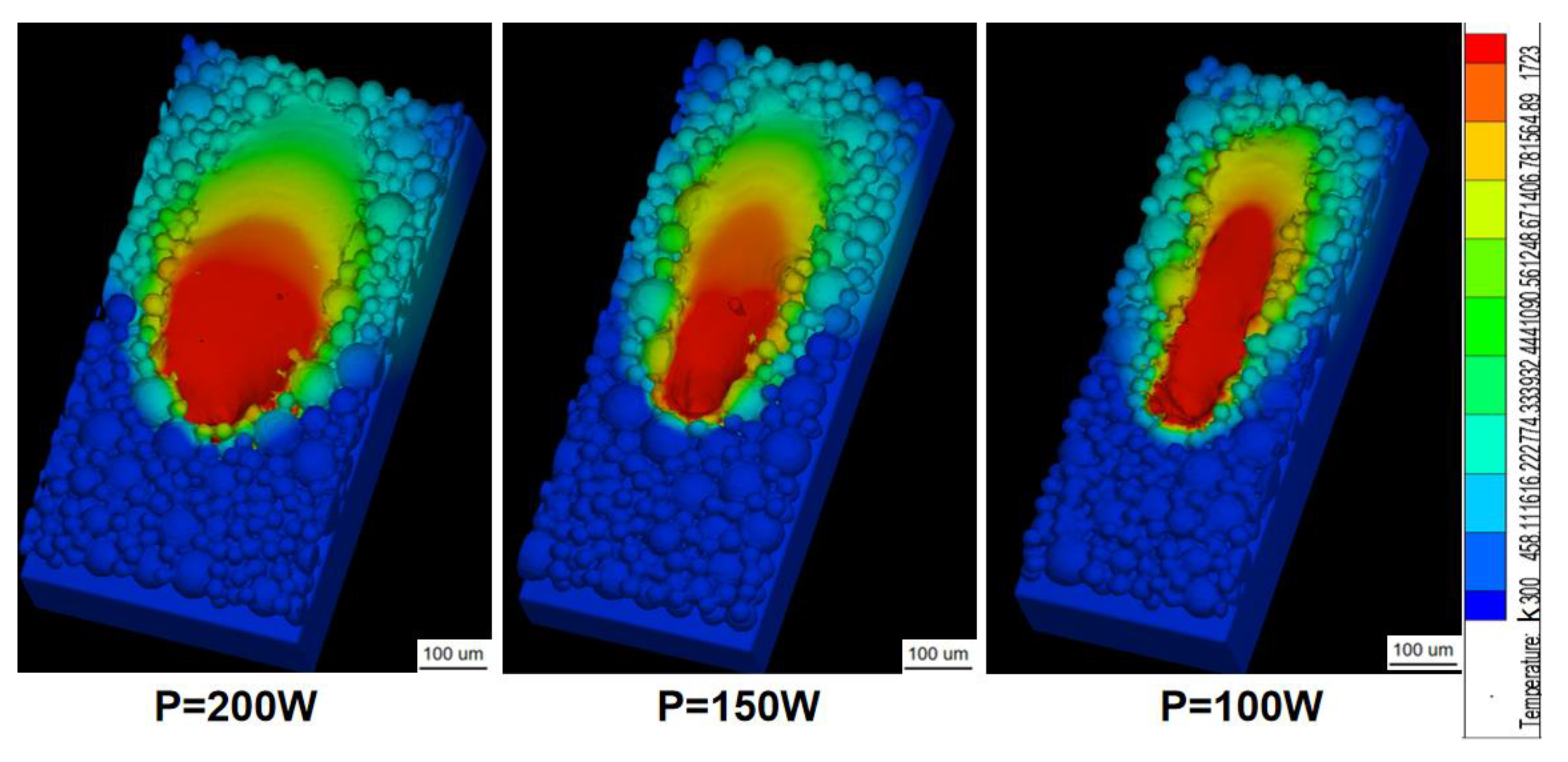

| Parameter | Values |
|---|---|
| Density of solid metal (ρs) | 7200 (kg·m−3) |
| Density of liquid metal (ρl) | 6900 (kg·m−3) |
| Surface tension at melting point σ0 | 1.2 (N/m) |
| Surface tension gradient coefficient | −0.00043 (N·m−1·K−1) |
| Solid metal specific heat Cs | 700 (J·kg−1·K−1) |
| Liquid metal specific heat Cl | 780 (J·kg−1·K−1) |
| Melt latent heat L | 247000 (J·kg−1) |
| Liquidus temperature TL | 1773 (K) |
| Melting temperature Tm | 1723 (K) |
| Solidus temperature Ts | 1673 (K) |
| Boiling temperature Tboi | 3050 (K) |
| Solid metal thermal conductivity λs | 36.316~37.102 (W·m−1·K−1) |
| Liquid metal thermal conductivity λl | 18.06~18.22 (W·m−1·K−1) |
| Parameter | Values | |
|---|---|---|
| powder bed particles | density | 7800 (kg·m−3) |
| elastic modulus | 2.06 (GPa) | |
| Poisson’s ratio | 0.3 | |
| powder particles | static friction coefficient | 0.5 |
| rolling friction coefficient | 0.04 | |
| restitution coefficient | 0.5 | |
| 304 L | density | 7200 (kg·m−3) |
| elastic modulus | 1.98 (GPa) | |
| Poisson’s ratio | 0.3 | |
| 304 Land powder particles | static friction coefficient | 0.4 |
| rolling friction coefficient | 0.03 | |
| restitution coefficient | 0.4 | |
Disclaimer/Publisher’s Note: The statements, opinions and data contained in all publications are solely those of the individual author(s) and contributor(s) and not of MDPI and/or the editor(s). MDPI and/or the editor(s) disclaim responsibility for any injury to people or property resulting from any ideas, methods, instructions or products referred to in the content. |
© 2023 by the authors. Licensee MDPI, Basel, Switzerland. This article is an open access article distributed under the terms and conditions of the Creative Commons Attribution (CC BY) license (https://creativecommons.org/licenses/by/4.0/).
Share and Cite
Wu, J.; Ma, J.; Niu, X.; Shen, M.; Wei, T.; Li, W. Numerical Simulation of Selective Laser Melting of 304 L Stainless Steel. Metals 2023, 13, 1212. https://doi.org/10.3390/met13071212
Wu J, Ma J, Niu X, Shen M, Wei T, Li W. Numerical Simulation of Selective Laser Melting of 304 L Stainless Steel. Metals. 2023; 13(7):1212. https://doi.org/10.3390/met13071212
Chicago/Turabian StyleWu, Jie, Ju Ma, Xiaofeng Niu, Mengqing Shen, Tingting Wei, and Wenqi Li. 2023. "Numerical Simulation of Selective Laser Melting of 304 L Stainless Steel" Metals 13, no. 7: 1212. https://doi.org/10.3390/met13071212






